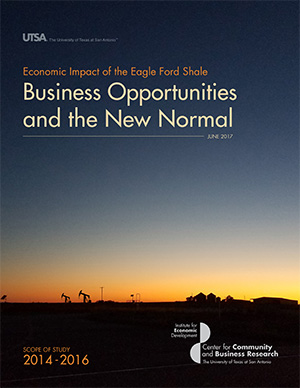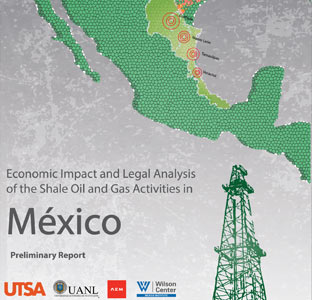Oil rig counts in the Eagle Ford Shale region began to rise after bottoming in 2016, and are expected to continue rising steadily in 2017.
SAN ANTONIO, (June 21, 2017) – Commissioned by the South Texas Energy and Economic Roundtable (STEER), The University of Texas at San Antonio’s (UTSA) Center for Community and Business Research (CCBR) completed the latest Eagle Ford Shale (EFS) study in June. The study titled, “Economic Impact of the Eagle Ford Shale, Business Opportunities and the New Normal” provides new trend data and updated economic impact analysis across 2014, 2015 and, 2016.
“Economic Impact of the Eagle Ford Shale, Business Opportunities and the New Normal”
at bit.ly/EFS_Report2017
Dr. Thomas Tunstall, senior research director for CCBR, which is hosted at UTSA’s Institute for Economic Development, led the study with his team of researchers. “Our report indicates that the decrease in economic impact bottomed out in 2016 and appears to have turned the corner. Oil prices in 2017 are higher and rig counts have risen from their lows last year,” Tunstall said.
After several years of unprecedented growth, the Eagle Ford Shale experienced a sharp decline in oil prices. The decline may have negatively impacted businesses and jobs in the area, however the current scenario offers more job opportunities in the region when compared to past decades of declining population and jobs in several counties in the shale area.
Gross output from Eagle Ford activity across the 21 county area jumped from $87 billion in 2013 to $123 billion in 2014. In the years since the peak occurred in 2014, gross output from Eagle Ford activity fell to $80 billion in 2015, and again in 2016 to $50 billion. And, while jobs supported by the Eagle Ford also peaked in 2014 at 191,153, up from 154,984 in 2013, by 2016, the number of jobs supported had fallen to 108,213.
“Although we experienced a decrease in jobs and economic impact in 2015 and 2016, we continue to see that the oil and gas industry is essential to the livelihood of South Texas. With more than 100,000 jobs and $55 billion in economic output last year, the results of the UTSA study further illustrates the importance of the oil and gas industry to South Texans. The industry in South Texas brought much needed infrastructure along with a sustainable source of income to the area. Sustained growth will further benefit the region through an increased tax base along with increased job and educational opportunities,” said Omar Garcia, president and CEO of STEER.
Since August 2014, the West Texas Intermediate (WTI) oil price dropped from more than $100 per barrel to $43.4 by March 2015, and by February 2016 it was close to $26.2 per barrel. Since then however, the price has recovered and by January 2017 it had reached $53.0 per barrel, signaling important opportunities for future growth as the price more than doubled in less than one year.
Additionally, a variety of industry sectors have also grown in the Eagle Ford area; many, but not all, are directly or indirectly associated with oil and gas activity. In 2015, U.S. natural gas exports to Mexico topped one trillion cubic feet annually – a new record. And, in 2016, U.S. natural gas production reached an annual record of 28 trillion cubic feet.
The Study provides analysis for the 21-county study area as a whole, both the Eagle Ford Shale 15-county core area as a whole (Atascosa, Bee, DeWitt, Dimmit, Frio, Gonzales, Karnes, La Salle, Lavaca, Live Oak, McMullen, Maverick, Webb, Wilson, and Zavala) and the six adjacent counties as a whole (Bexar, Jim Wells, Nueces, San Patricio, Victoria, and Uvalde). The second phase of the Study includes breakouts for all 21 counties individually and compares inter-industry relationships from 2010-2015. The comparison of different multipliers demonstrates how employment and production have been affected in the area.
UTSA and STEER representatives plan on traveling to Eagle Ford cities in late June to discuss the results of the 2017 Eagle Ford Shale Economic Impact Study with community leaders and the general public. The tour follows the Eagle Ford Consortium Inc.’s (EFCI) annual conference, which focused on the ongoing activity of the Eagle Ford and was hosted at UTSA’s downtown campus from June 7-8.
“The Eagle Ford Shale play became a boon to the South Texas economy, and provided an opportunity to boost local infrastructure. Our region is well positioned for a successful future as local area production picks back up. South Texas has become an export leader in the energy products realm. We are committed to continued sustainable growth,” said John LaRue, Port Corpus Christi executive director.
Access the Full Study: “Economic Impact of the Eagle Ford Shale, Business Opportunities and the New Normal” at bit.ly/EFS_Report2017
Center for Community and Business Research: ccbr.iedtexas.org
Institute for Economic Development: iedtexas.org
About the UTSA Institute for Economic Development
The UTSA Institute for Economic Development is dedicated to growing businesses, creating jobs and fostering economic development. Focused on building the economy one business at a time, the Institute consists of 10 centers and programs that provide professional business advising, technical training, research and strategic planning for entrepreneurs, business owners and community leaders. These programs serve Greater San Antonio, the Texas-Mexico border area as well as regional, national and international stakeholders. Together with the federal, state and local governments, and private businesses, the UTSA Institute for Economic Development fosters economic and community development in support of UTSA’s community engagement mission. In 2016, the Institute generated direct regional economic impact of 7,517 jobs, started 591 new businesses, $447 million in new financing, $78 million in new tax revenue and exceeded $1.4 billion in new sales, exports and contracts.
For more information, contact
Jennilee Garza, Senior Communications Coordinator
Institute for Economic Development
Phone: 210-458-2958
jennilee.garza@utsa.edu













